Racing's wildest series threw up racing's wildest car. Surround yourself with 400 litres of race fuel and fire up that 1200bhp flat-12: this is the Porsche 917/30 CanAm Spyder.
Text: Richard Meaden, Photos: Matthew Howell. October 2014
Nine One Seven Thirty. I’ve never won the lottery, but when an invitation to track-test a legendary 1970s Porsche racing car includes this magical four-number sequence, the resultant feeling of excitement, disbelief and a strange, fearful unease can’t be too dissimilar. Whether you’re suddenly presented with boundless wealth or a fleeting taste of boundless horsepower, life is unlikely to be quite the same again.
As many of you already know, the 917/30 is the holy grail of racing cars. The ultimate expression of CanAm’s unique sky’s-the-limit approach to technical 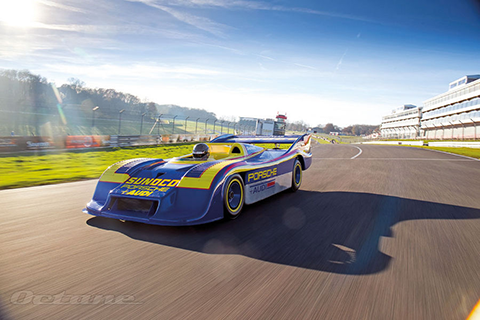 regulations, this 1200bhp twin-turbo monster was a sensation, rubbing salt into the opposition’s wounds by totally dominating the 1973 season after its predecessor – the 917/10 – had given them a savage mauling the previous year. Fearing a third consecutive drubbing for teams powered by naturally aspirated big-block American V8s, for 1974 CanAm’s organisers imposed a fuel limit on turbocharged cars. In other words, the Porsches. This protectionist measure appeased the other teams, but effectively forced the Stuttgart marque’s withdrawal from the series. This disappointed fans and, with interest waning, the most extraordinary race series in history fizzled out at the end of the year.
regulations, this 1200bhp twin-turbo monster was a sensation, rubbing salt into the opposition’s wounds by totally dominating the 1973 season after its predecessor – the 917/10 – had given them a savage mauling the previous year. Fearing a third consecutive drubbing for teams powered by naturally aspirated big-block American V8s, for 1974 CanAm’s organisers imposed a fuel limit on turbocharged cars. In other words, the Porsches. This protectionist measure appeased the other teams, but effectively forced the Stuttgart marque’s withdrawal from the series. This disappointed fans and, with interest waning, the most extraordinary race series in history fizzled out at the end of the year.
Consequently Porsche and the 917/30 have always been portrayed as villains, charged with the crime of killing CanAm in cold blood. Perhaps if Roger Penske had allowed Porsche to supply other teams with the 917/10 in 1972 and the 917/30 the following year there might have been more intra-marque competition but, as Penske and his genius driver/engineer Mark Donohue were the driving force behind Porsche’s CanAm campaign, it’s not unreasonable that they insisted upon being the only team to run the cars in their debut years.
Ironically this car – chassis 917/30 005 – could also be seen as a victim: collateral damage in the wake of Porsche’s ’73 success. Commissioned at the end of that year as a reserve car for the Penske team in readiness for the ’74 CanAm season – when the rule-change came and Porsche withdrew – all work stopped, denying 005 the chance to turn a wheel in anger. The part-built car then languished with Porsche Motorsport until 1979, when Gerry Sutterfield (a Florida-based Porsche dealer and serious collector of Porsche racing cars) approached the factory to see if he could acquire a 917/30. Terms were agreed and the motor sport department began working on 005 in the summer of ’79, finally handing over the finished car in February 1980.
Since then 005 has changed ownership a number of times, moving from one exceptional car collection to the next. With the present owner – Australian enthusiast Peter Harburg – placing his beloved cars with auction house RM for sale at the Rétromobile event in Paris next month, a new chapter of this extraordinary car’s life is about to begin. Before then, however, Harburg has given his blessing to a pre-auction track test, which is how I find myself in the somewhat surreal position of being stood in the paddock at Brands Hatch while Jürgen Barth – Porsche Motorsport legend and former factory driver – warms-up the 917/30 in readiness for my drive.
It’s hard to describe how you feel in the presence of this car, as technicians lovingly warm the block with a space heater (today’s ambient temperature is barely above freezing!), then spin the loud starter motor for an age before finally, one by one, each of the dozen horizontally opposed cylinders sputters into life. Even at idle the noise is all-pervading: a thumping, combative, physically draining wall of decibels that drills into your skull and reverberates around your chest cavity. As heat begins to percolate into the exotic alloy bones of this brutal engine, Barth winds on some revs, holding the throttle steady at each of what sound like 500rpm increments, the flat-12 mimicking a singer warming their vocal cords.
Smoke, sweet and heavy with unburnt hydrocarbons, begins to fill the pit garage. Each lunge of revs enriches the high-octane fug until your eyes begin to sting with a painful intensity equal to that of the ringing in your ears. Barth appears impervious to the roiling mix of noise and noxious fumes that surrounds him, but I have to escape, eventually blinking and gasping into the cold, crisp Kentish air as the 917 continues to roar and rage in its lair. And this on the very same day Porsche announces its new LMP1 Le Mans challenger is a four-cylinder petrol/electric hybrid...
With the warm-up procedure complete, I venture back into the garage for a closer look. The 917/30 is a very different animal from the delicate, curvaceous 917s that raced in Europe. Indeed it looks very different even from the 917/10 Can Am car that preceded it, thanks to the deceptively clean, low-drag, high-downforce ‘Paris’ bodywork that was designed by a French aeronautics company and then further developed by Donohue, Penske and Porsche in a pivotal if somewhat haphazard test at Paul Ricard in the winter of 1972.
On discovering the new bodywork offered little or no improvement over the old 917/10’s, the Porsche team set about fabricating a rough approximation of the long tail from a Le Mans 917 and adapting it for the CanAm car. It worked immediately, Donohue pushing the 917/30’s disappointing maximum speed on the Mistral straight from 212mph to a rampant 240mph without significantly compromising corner pace or high-speed stability. While the twin-turbo flat-12’s astonishing power and torque fuelled 917/30 legend, it was this aerodynamic breakthrough that would maximise its potential.
The shape is as no-nonsense as the performance it released: broad-hipped with slab sides and simple curves, it looks like a chunky, big-boned machine, yet look beneath the skin and nothing could be further from the truth. Unlike the rival McLarens, which featured more advanced – and substantial – aluminium monocoques, the 917/30 still relied upon a complex criss-cross of small-diameter aluminium tubing, which was stitched together to form a spindly-looking spaceframe, just as all Porsche’s sports prototypes had been since the 1950s. With bodywork removed this lightweight structure can be seen in all its beautiful, terrible glory: a fine gossamer web of tubes cradling the vast flat-12 engine, gearbox and fuel tanks, with the driver pushed right up at the pointy end and with his feet and lower legs in effect forming the most substantial components of the 917/30’s front structure.
It’s easy to survey this absurdly perilous construction and console yourself with the thought that teams and drivers didn’t know any better, but the truth is that everyone knew how brutally dangerous these cars were should the worst happen. That few were more intimately acquainted with the perils of crashing a CanAm 917 than Mark Donohue makes his peerless dominance of the 1973 CanAm series even more impressive. In his seminal book The Unfair Advantage, Donohue describes the monumental shunt he suffered at the wheel of a 917/10 early in the 1972 season.
It makes chilling reading: ‘I don’t remember seeing much of the front end go away. Suddenly the bodywork was gone and I could see twisted tubes and bars. Then the right front wheel just kind of went away from me.
I don’t know if it was up, down or sideways, but it went away like a slow-motion dream. I didn’t see the frame, or dash, or steering wheel go either as I was trying so hard to pull myself into my seat. And then there was silence. I looked around – and I was sitting on the grass, still strapped into my safety seat, with the motor right behind me, and nothing ahead of me. No front end, no frame, no wheels, no body, no fuel tanks – just me, my seat, some tubes and the roll bar… then I noticed my left leg was bent at a funny angle. It bent 45º at the knee, and was lying on top of my right leg… I thought it was possible what was left of the car might blow up, so I dragged myself clear across the track by my hands. By that time I was hurting so bad I couldn’t believe it.’
Before leaving home for Brands Hatch I’d vowed to keep Donohue’s graphic description swirling around at the forefront of my mind, if only to remind myself that today is not about heroics or ego. These track tests never should be but, like anyone who’s ever pulled on a crash helmet and strapped themselves into a racing car, you find it hard not to yield to the temptation of measuring your own limits against those of the car you’re sitting in.
Having seen – and heard – this Goliath of a machine limbering-up, I’m not ashamed to say that the notion of doing anything other than respectfully tickling round the Brands Hatch Indy circuit for my allotted laps and bringing the car back in one piece now seems totally absurd. This is underlined when Barth heads out for a few exploratory laps of the circuit – treacherous with meltwater from overnight ice! – and proceeds to spin the massive rear Avon intermediates at will. Gulp.
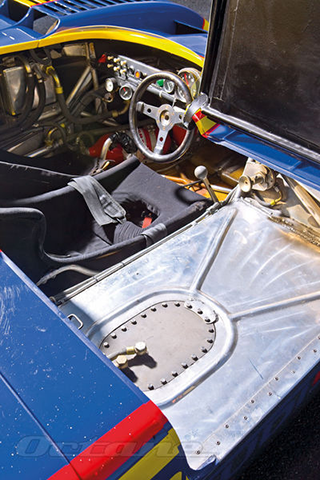 All racing cars have their characteristic ingress rituals and the 917/30 is no different. To begin, you have to flip up the flyweight aluminium ‘door’, in much the same manner a pub landlord lifts the cut-out in the bar. You’re then confronted by the flat expanse of fuel tank, which forms a sill that’s a good 2ft wide. There’s an awkward moment of indecision while you grapple with the conundrum of which piece of precious Porsche to use as a step, until Barth invites you to place your size 9 on the flat top of the fuel cell before standing on the seat with both feet and then lowering yourself down behind the small, leather-rimmed steering wheel.
All racing cars have their characteristic ingress rituals and the 917/30 is no different. To begin, you have to flip up the flyweight aluminium ‘door’, in much the same manner a pub landlord lifts the cut-out in the bar. You’re then confronted by the flat expanse of fuel tank, which forms a sill that’s a good 2ft wide. There’s an awkward moment of indecision while you grapple with the conundrum of which piece of precious Porsche to use as a step, until Barth invites you to place your size 9 on the flat top of the fuel cell before standing on the seat with both feet and then lowering yourself down behind the small, leather-rimmed steering wheel.
It doesn’t really bear thinking about but, when brimmed for the start of a CanAm race, the 917/30 driver would be literally surrounded by 400 litres of race fuel. That this monstrous load would be devoured in a little over an hour of racing tells you all you need to know about the prodigious thirst of that 1200bhp motor but, when you consider the dry weight of the 917/30 was just 800kg, you also begin to appreciate the explosive power-to-weight ratio CanAm regs fostered. Quite simply, no racing formula before or since has shown such single-minded dedication to free thinking and mind-warping performance.
Starting a 917/30, depressing the weighty clutch, pulling the right-hand gearlever into first and heading off down the Brands Hatch pitlane is one of life’s more memorable moments. With acres of iconic inky-blue, sun-yellow and blood-red bodywork around you, it’s easy to forget your feet are resting on pedals located way beyond the centreline of the front wheels and that the steering rack sits inches above your shins, but a glance around the crude cockpit provides a graphic reminder of the 917’s inherent structural frailty. Instrumentation is basic, the view ahead dominated by a large tacho, which is redlined at 8000rpm. Barth says we can run to 6000rpm, which (hopefully) safeguards us from buzzing the notoriously rev-critical flat-12 and, presumably, means the pair of snails are only just beginning to wind themselves into delivering that fabled tornado of boost.
At first it’s hard to quell the rising sense of panic as you try to get the most basic measure of how the car behaves as quickly as you can, but it soon becomes clear that the steering has surprisingly manageable weight and an encouraging feeling of connection, despite cold tyres and a frigid track surface. The four-speed gearbox is similarly helpful, largely thanks to Porsche’s preference for synchromesh, and the sleeping giant of an engine has more than enough muscle to be tractable at low revs.
For a machine defined by gargantuan power and prolapse-inducing acceleration (0-62mph in 2.2sec, 0-124mph in 4.5sec, 0-186mph in 11sec), the irony of trying to negotiate the first few laps without summoning a potentially career-ending rush of turbo-boost is not lost on me. Such prudence is quickly rewarded with a growing and frankly irresistible urge to push deeper into the firm throttle’s long travel until you feel the preternatural shove of forced induction pick you up and shove you down the track with the force of a tidal surge. When you do there’s the very real sense of being strapped to a runaway train, coupled with a disorientating sense of detachment. Epic turbo lag means the engine is constantly playing catch-up with your right foot. Under acceleration you have to get on the power much earlier than you would in a quick-witted non-turbo car, but somewhat unexpectedly the same principle is true under braking, when the boost continues to build after you’ve backed-out of the throttle.
The Brands Hatch Indy circuit isn’t exactly ideal for a car endowed with a 240mph stride, especially one with four forward gears, yet, far from feeling off-boost and over-geared, the flat-12 pulls and pulls hard, even when you’ve short-shifted into third for the short run between Graham Hill Bend and Surtees. As the revs build and the boost pressure rises, the engine note hardens, then the rear wheels break traction. Not in a wild frenzy of gratuitous wheelspin, but in a measured, insistent manner that comes from having truly awesome torque on-tap at modest throttle openings.
For Donohue – that most cerebral and sensitive of drivers – the process of learning the 917/30’s unique foibles until they became second nature was as rewarding as the raw speed was exciting. Pushing it to the limit must have been like catching a dragon by the tail, but even the most limited exposure to its monumental performance provides a fleeting glimpse of a driving challenge so intoxicating you can feel yourself falling deeper under its spell with each and every squeeze of that heavy throttle.
Lapping two seconds faster than anyone else, as Donohue did, must have been as close to a state of invincibility as any racing driver has achieved. To be a mere mortal afforded the privilege of experiencing a fraction of what he did is to understand why, 41 years after it last raced, the 917/30 remains the most extraordinary racing car the world has ever seen – and Donohue is revered as the only man who tamed it.
For more from the historic car world, try Octane magazine.
Subscribe today and get 3 issues for £5
Related Features
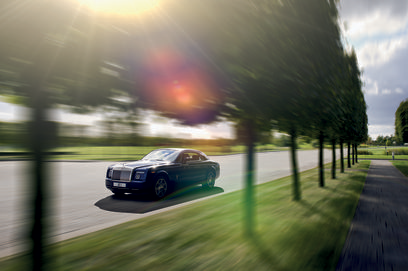
Until 'Johnny English Reborn' no one outside of Rolls-Royce knew about this fabulous V16 powered Phantom. That is, until Rowan Atkinson needed something special for his latest film.
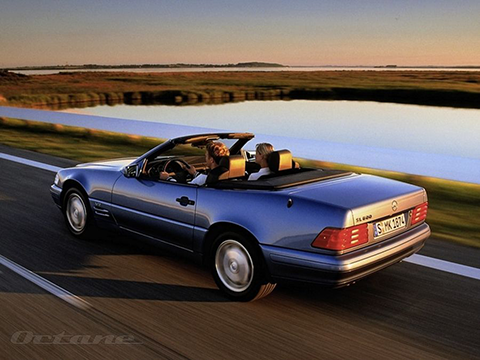
The advertising tag-line for the Mercedes-Benz SL was 'Engineered like no other car', and we reckon it's justified – especially at today's prices.
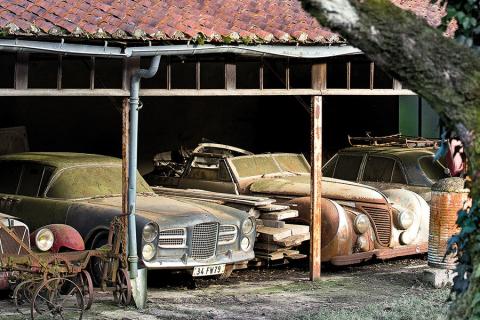
Imagine stumbling across a vast collection of rare and valuable cars, hiding in the grounds of a romantic French château. This is what it feels like...